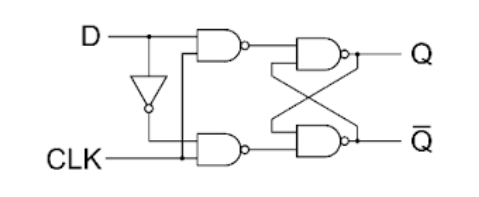D-Type Flip Flop
A D-type flip flop is a logic circuit used to store an alternating value. The circuit is composed of a clock input (which itself is the output of a different logic circuit), a control input D and an output Q. The circuit is edge-triggered, meaning that the value of Q can change each time the clock input has a rising edge (where it changes from 0 to 1), which occurs at regular intervals.
Q begins with the same value as D. When a rising edge occurs in the clock, Q changes to match the value of D. This means it could remain the same or change depending on the value of D.

Adders
An adder is a logic circuit used to add two binary numbers and calculate the carry value. It simulates a long binary addition.
Half Adder
A half adder is used to calculate the total of two binary numbers and the carry value that would be needed when performing a binary addition. However, it doesn’t take into account of a previous carry.

Full Adder
A full adder has the same function as a half but also inputs a carry. This means it is the same as two combined half adders.

